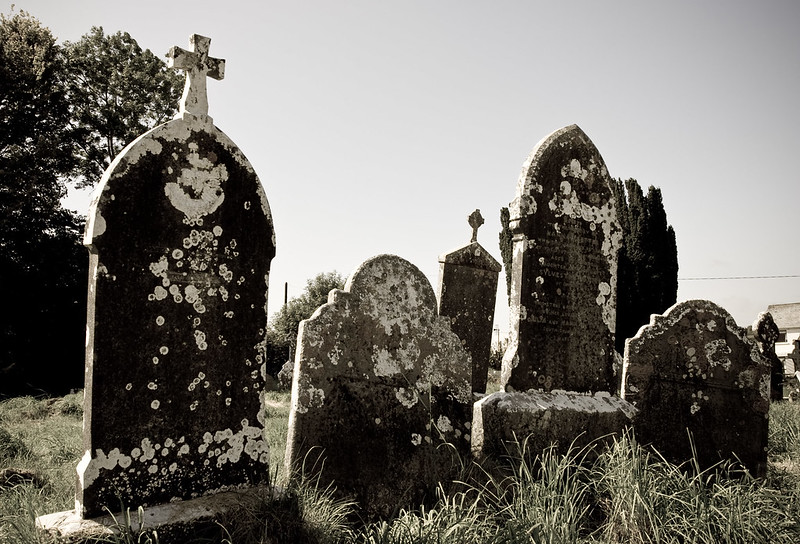
More than a quarter-century after the Good Friday peace agreement, Northern Ireland remains divided along sectarian lines. In Belfast, imposing “peace walls” continue to cast long shadows, preventing interaction between one side and the other. Gardens of remembrance and murals are located near or even on the walls. Some sites memorialize paramilitaries, grieving and glorifying the dead. Others sacralize violence: in Protestant areas, the slogan “For God and Ulster” dominates; in Catholic areas, hunger strikers are depicted as Christ-like martyrs, laying down their lives for others.
Catherine Corless’ history of the Bon Secours Mother and Baby Home in Tuam, Co Galway, published in 2012, exposed the burial of 796 infants in a septic tank, their graves unmarked. More than a decade later, local people have adorned the site with memorials: a list of names, a plaque, photographs, baby shoes, and teddies.
The tragic and unnecessary deaths that took place during the Troubles and in the island’s church-run institutions may at first seem unrelated. Yet they can be linked to the churches’ historic pursuit of power, which resulted in the sins of sectarianism and cultures of abuse. Belfast’s peace walls and the grounds of Tuam’s Mother and Baby Home are just some of the many spaces and places where the ghosts of the island’s Christian past haunt the present and in doing so make demands on the future.
The churches, of course, are not solely responsible for these tragedies. And since the middle of the twentieth century, the churches’ social and political power has waned. But the churches can still address their own legacies and in that way contribute to alternative futures which include healing rather than (or, perhaps more realistically, alongside) pain.
Hauntings: The Ghosts of Religion Past
“Hauntings” and “ghosts” are not topics usually considered by social scientists, but they have gained traction as social scientific concepts in recent decades. Jacques Derrida’s 1994 Specters of Marx can be considered a starting point.
Building on Derrida, conceptions of hauntings alert us that, first, it is impossible to forget or suppress the past. Memories of traumas work their way into the present through anniversaries of atrocities, the recovery of the bones of the dead, the intergenerational transmission of violent patterns of relating, and so on.
Second, social scientific conceptions of hauntings are focused on justice, with the ghosts urging their descendants to right the wrongs of the past. As Avery Gordon insists: “To be haunted in the name of a will to heal is to allow the ghost to help you imagine what was lost that never even existed, really. … [it is] to long for the insight … that it could have been and can be otherwise” (57).
So, we can ask of the churches’ roles on the island of Ireland: What could have been and can be otherwise? But first, we must explore the churches’ sins.
Sins: Sectarianism and Cultures of Abuse
Sectarianism pre-dates the partition of the island in 1921, having become embedded during post-Reformation periods of “plantation” (or colonization). Over centuries, the churches contributed to processes that not only produced enmity between people of different Christian traditions, but created social, political, and economic structures that divided people and favored some over others across the entire island.
It is understandable that sectarianism is often reduced to a northern phenomenon, given the relationship between sectarianism and the violence of the Troubles. Despite reforms that have reduced inequalities and the introduction of power-sharing in the Northern Ireland Assembly, the legacies of sectarianism persist in continued segregation along “religious” lines in schools, neighbourhoods, and marriage patterns; prejudicial attitudes; and inter-generational trauma. Yet, as I have shown elsewhere, in the south religious segregation also exists (albeit to a more limited extent), and despite its recent fall from grace, the Catholic Church continues to hold a privileged cultural and societal position, including in its role in education, cultural rites of passage, and healthcare.
A culture of abuse is most closely associated with the southern state, the Republic of Ireland. The term “culture of abuse” emphasizes that the widespread abuse of women and children (and some men) in the churches—especially the Catholic Church—cannot be reduced to the acts of individual perpetrators. Derek Scally’s The Best Catholics in the World explores how state and society enthusiastically embraced Catholicism as integral to its identity, then pursued policies that promoted a self-image of a holy, Catholic Ireland. This was, in some ways, a response to the centuries-long experience of colonization by an aggressively Protestant (and anti-Catholic) British state.
After independence, the southern state granted the Catholic Church far-reaching control in education and health, and Catholic social teachings were reflected in law. Those who did not conform to this pious self-image were institutionalized in Magdalene Laundries, Mother and Baby Homes, or industrial schools. In these institutions the inmates (and yes, this is the most accurate term) endured forced labour and other forms of physical and emotional abuse. At the same time, the all-island structures of the churches, which pre-date partition, remind us that cultures of abuse were island-wide. In addition, the British state (of which Northern Ireland is officially a part) abdicated some responsibilities to churches in education, health, and care, facilitating abuses of power.
We return, then, to Gordon’s question: What could have been and can be otherwise? What would have happened had the island’s churches resisted the temptation to align themselves with political power in their quest to secure societal influence through rigid compliance? What if the churches had chosen loving service? In the twenty-first century, the island’s churches have, at least haltingly, begun to reckon with their sins of sectarianism and abuse.
Apologies: Addressing the Ghosts?
In 2021, the Church Leaders’ Group released a St Patrick’s Day video message. Noting the centenary of the partition of the island and creation of Northern Ireland, the message advocated reflection on the past as a basis for building a better future.
The Church Leaders’ Group consists of the Catholic and Church of Ireland Archbishops of Armagh, the Presbyterian Moderator, and the Presidents of the Methodist Church and the Irish Council of Churches. As I’ve discussed, during the video, Catholic Archbishop Eamon Martin delivered the churches’ most comprehensive confession ever for their historic contributions to division and violence:
As Christian churches we acknowledge and lament the times that we failed to bring to a fearful and divided society that message of deeper connection that binds us, despite our different identities, as children of God, made in His image and likeness. We have often been captive churches; not captive to the Word of God, but to the idols of state and nation.
Since then, these church leaders have offered further apologies and publicly declared that the churches are willing to facilitate efforts to “deal with the past.” We might conclude that the churches, or at least these leaders, have begun to heed the ghosts’ pleas for justice. Yet these apologies have not captured the public imagination in the way they might have had they come several decades earlier, when the churches had more influence.
Apologies for abuse have received more public attention. But these apologies have been ineffective because of the words chosen by leaders when delivering them. In 2010 Cardinal Seán Brady apologized for “hurt” caused by “any failure on my part”—avoiding the acceptance of responsibility (8). Similarly, Cardinal Desmond Connell deflected responsibility in his apology after the 2009 Murphy Report into abuses in the Dublin archdiocese.
There have been five official state apologies for historical abuse in church-run institutions. They have been better received than apologies by church leaders. This may be because the state has implemented some measures for redress. Religious orders have paid just €128 million of the €1.5 billion in compensation (102).
James Gallen argues that apologies on their own are not enough to deal with the legacy of the past, functioning only “as episodic forms of power” for victims/survivors and failing to address “broader structural, epistemic, and ontological forms of power” (223). Likewise, John Brewer claims that people cannot “remember forwards” in a positive way unless “social betterment and improvement help break the haunting hold that the past has over the future” (42).
How, then, might the island’s churches break that haunting hold and put their own ghosts to rest?
Alternative Futures
I want to suggest two ways the churches might move on from apology and construct alternative futures: theology and witness. The first, theology, could start with the island’s best-known theologian of the twentieth century, Enda McDonagh, who was influenced by liberation theology, including its post-colonial context. Other theologians have articulated theologies of reconciliation, including David Tombs, Leah Robinson, Siobhan Garrigan, and Maria Power. Tombs has also explored theologies of trauma and abuse. The public theology of Methodist Johnston McMaster has been significant for its critiques of churches’ abuses of power.
There are also strong foundations for pursuing the second way: witness. Witnesses against violence and injustice—usually individuals and small groups—were present in the churches’ past. Their work has been documented in academic studies and biographies and memoirs of clergy who contributed to peacebuilding. Some victim-survivors of abuse, such as Marie Collins, retain their Christian identities and can be considered witnesses to what could have been and can be otherwise.
The churches may struggle to incorporate these challenging witnesses into their own stories as institutions, given that their very witness critiques those institutions. But it is the stories of these people that could inspire younger generations to focus on justice, reforming the churches from within. This would require that the churches acknowledge and celebrate these witnesses, and perhaps even facilitate mentoring relationships between aging witnesses and younger Christians. For it will only be through the flesh-and-blood bodies of the next generation that visions for what can be otherwise will be lived out, animated by the witness of those who went before and by fresh theologies that through the pursuit of justice, put the ghosts of the past to rest.

